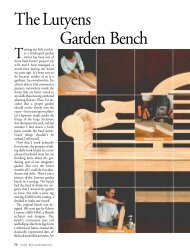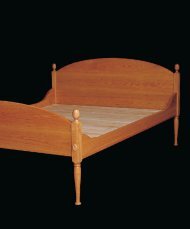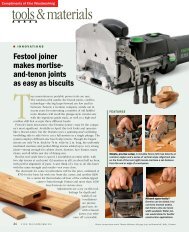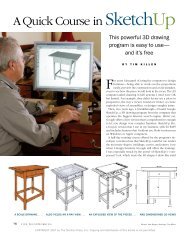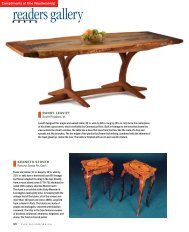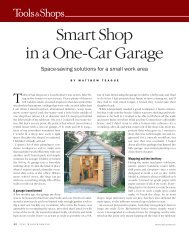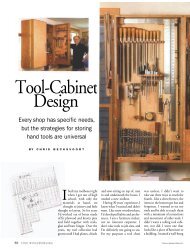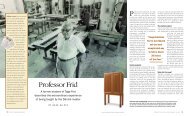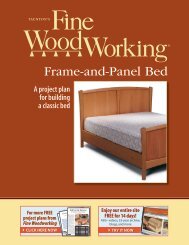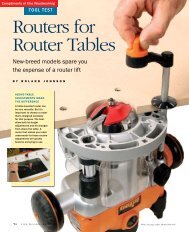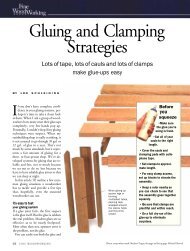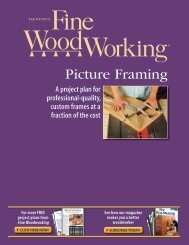Arts & Crafts Style Chair - Fine Woodworking
Arts & Crafts Style Chair - Fine Woodworking
Arts & Crafts Style Chair - Fine Woodworking
Create successful ePaper yourself
Turn your PDF publications into a flip-book with our unique Google optimized e-Paper software.
4. The depth of the mortise is con-<br />
trolled by the plunge mechanism on<br />
the router. The author secures stock<br />
to the jig with C-clamps.<br />
nets that come into contact with water, I<br />
had been hesitant to use such a finish until<br />
I read about Sam Maloof's three-part formula.<br />
He mixes equal parts of raw rung oil,<br />
boiled linseed oil and polyurethane. The<br />
polyurethane prevents this finish from<br />
showing water spots.<br />
With the temperature about 50° to 60°F, I<br />
sprayed this concoction on the chairs and<br />
let it soak in for 10 to 20 minutes. After that,<br />
I wiped it off with a rag, using a circular motion.<br />
I repeated this procedure two times,<br />
letting each coat dry a few days. Then I<br />
gave all the surfaces a final buff with #0000<br />
steel wool.<br />
The Maloof technique also calls for another<br />
mixture: equal parts tung oil, boiled<br />
linseed oil and beeswax. To make this, I<br />
melted some beeswax in a double boiler<br />
on the stove. While that was still in liquid<br />
form, I added the tung and linseed oils,<br />
mixing them together. When this mixture<br />
cools to a paste, it's easy to apply with a<br />
cotton cloth, rubbing in a circular motion.<br />
I applied three coats to the chairs. The<br />
beeswax gave this finish a nice, satiny glow.<br />
The frame and fiber rush seat<br />
Unlike most chairs made with a rush seat,<br />
this one has a separate frame screwed into<br />
place after it was woven. Fiber rush exerts a<br />
tremendous amount of pressure on a<br />
frame, so I decided to use plywood, figur-<br />
Dry-assemble all the pieces. This dress rehearsal for the final assembly helps the<br />
author avoid the costly mistake of glued joints that don't fit.<br />
ing the multiple alternating layers would<br />
hold up better over time. A -in. piece of<br />
plywood, cut out in the middle to make a<br />
-in.-wide frame, worked best.<br />
To learn how to weave a rush fiber seat, I<br />
consulted an article in FWW #85 (p. 51). As<br />
a source book for materials, The Carter's<br />
Handbook by Bruce W. Miller and Jim<br />
Widess came in handy. It is published by<br />
Lark Books, 50 College St., Asheville, NC<br />
28801, and it's available from Woodcraft<br />
Supply (800) 542-9115 or The Woodworkers'<br />
Store (800) 279-4441. The weaving<br />
process was time-consuming. Each seat<br />
took about a day to complete.<br />
Rex Alexander builds furniture, cabinetry<br />
and millwork in Brethren, Mich.<br />
Further reading<br />
Gustav Stickley built many fine<br />
examples of <strong>Arts</strong>-and-<strong>Crafts</strong> furniture<br />
in his factory. He also left a wealth of<br />
information in his monthly magazine<br />
The <strong>Crafts</strong>man (1901-1916). Much of<br />
this information has been republished<br />
in two books: <strong>Crafts</strong>man Homes,<br />
Architecture and Furnishings of the<br />
American <strong>Arts</strong> and <strong>Crafts</strong> Movement<br />
and Making Authentic <strong>Crafts</strong>man<br />
Furniture, both published by Dover<br />
Publications, 31 E. 2nd St., Mineola,<br />
NY 11501. These books are available<br />
through Manny's Woodworkers Place<br />
(800) 243-0713.



